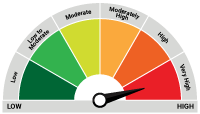Should You Invest in a Mutual Fund Scheme Only Looking at its NAV?
Posted On Tuesday, Jun 14, 2022
Many investors often face various dilemmas when it comes to mutual fund investment. One such crossroad that investors find themselves in is whether they should invest in a mutual fund scheme with a high NAV or low NAV.
But is investing in a mutual fund scheme based solely on its NAV the right approach?
First, let's understand what is mutual fund NAV...
The Net Asset Value (NAV) of a mutual fund scheme is nothing but the computed by taking Market or Fair Value of Scheme's investments (+) Current Assets (-) Current Liabilities and Provisions Divided by No. of Units outstanding under the Scheme on the valuation date. In other words, the asset value of the mutual fund reflects the market value of all the securities that it holds. This value is divided by the number of outstanding units (the number of units that the scheme has issued to investors) to calculate the NAV per unit. Since the markets are dynamic in nature, the mutual fund NAV changes every day.
The NAV of a mutual fund is calculated as below:
NAV per unit = [Total Assets – (Total Liabilities + Expenses)] / Total Number of Outstanding Units
NAV of all the schemes except Fund of Funds schemes needs to be calculated and disclosed on every Business Day by the Fund House on their website and on the website of Association of Mutual Funds in India www.amfiindia.com by 11.00 p.m. every business day. Fund of Funds schemes NAV be calculated and disclosed by 10.00 a.m. of the next business day.
Cut off Timing For Mutual Fund Transactions
| Type of Schemes | Transaction type | Cut-off timings |
| Liquid Funds & Overnight Funds | Subscription (including Switch-in from other schemes) | 1:30 p.m. |
| Redemption (including Switch-in from other schemes) | 3:00 p.m. | |
| All other schemes (other than Liquid Funds / Overnight Funds) | Subscription (including Switch-in from other schemes) | 3:00 p.m. |
| Redemption (including Switch-in from other schemes) | 3:00 p.m. |
As per SEBI circular no. SEBI/HO/IMD/DF2/CIR/P/2020/175 dated September 17, 2020 read with circular no. SEBI/HO/IMD/DF2/CIR/P/2020/253 dated December 31, 2020, effective from February 1, 2021, the applicable NAV in respect of purchase of units of mutual fund scheme shall be subject to realization & availability of the funds in the bank account of mutual fund before the applicable cut off timings for purchase transactions, irrespective of the amount of investment, under ALL mutual fund schemes.
Is a scheme with low NAV better?
It is a common misconception among investors that a mutual fund scheme that has a low NAV has better growth potential. Accordingly, many investors rush to buy new schemes lured by the 'low NAV' proposition. While doing so they often disregard whether the traits of the mutual fund schemes sync well with their envisioned financial goals and risk profile.
Simply put, mutual fund NAV does not tell if the scheme is available cheap or expensive. It simply denotes the current value of all the securities the scheme holds in its portfolio.
Generally, funds that have been in existence for a long time, for instance 10-15 years or more, have higher NAVs which suggests that they have performed well in the past. By avoiding a scheme that has a high NAV you may be penalizing it for its consistent performance track record. However, remember that there is no assurance that it will generate good returns in the future either.
On the other hand, newly launched funds (NFOs) have low NAVs. Most of them are launched at a NAV of Rs 10 per unit.
However, if the old scheme and the new scheme have invested in the same companies with similar weightage, they are likely to generate similar returns. The NAV will not have an impact on their growth potential in any way.
So while mutual fund NAV is a useful tool to determine its performance, it does not indicate its future prospects.
Consider this instance to get better clarity on mutual fund NAV calculation:
If, after one year, both funds have grown by 10%, the growth in NAV will be as below:
The NAV of Fund A will be 11, and the NAV of Fund B will be 55.
The value of your investment will be:
Fund A: 500 units x Rs 11 = Rs 5,500
Fund B: 100 units x 55 = Rs 5,500.
Thus, both the funds have generated similar returns irrespective of the NAV because they had similar portfolios.
Therefore, it is wrong to assume that a mutual fund available at a low NAV of, say, Rs 10 is cheaper than a mutual fund with a higher NAV of, say, Rs 100 per unit. A mutual fund with a higher NAV does not mean it is expensive. Similarly, a low NAV is not indicative that it is available at a bargain price.
Likewise, if two funds have similar NAVs, it does not mean that they will generate similar returns. At the most, funds in the same category may move in one direction; but the growth of the scheme will depend on the type of scheme, the fund manager’s investment strategy/style, and the quality of the underlying portfolio, among other factors.
Instead of assessing the mutual fund NAV, you should focus on the following parameters to select mutual fund scheme:
1) Risk-reward matrix
Evaluate the mutual fund’s past performance over various time frames such as 1-year, 3-year, 5-year, since inception, etc., along with performance comparison across past market phases vis-à-vis its peers and the benchmark index. This will give you a comprehensive idea about how consistently the mutual fund has performed. However, avoid relying too much on past performance because it is not indicative of future returns.
Also determine how well the fund has rewarded its investors for the risk they have taken using risk-reward ratios like Sharpe Ratio, Sortino Ratio, Standard Deviation, etc.
2) Portfolio characteristics
The growth potential of a mutual fund depends to a great extent on the quality of its underlying portfolio, i.e., stocks and other securities. A mutual fund scheme should be well-diversified across stocks/sectors and other securities depending on its investment mandate to avoid concentration risk.
The fund should also have a reasonable turnover ratio. High turnover can make a fund more volatile and also lead to a higher expense ratio, which can impact the overall returns.
3) Efficiency of the fund management team
Always choose mutual fund scheme that follow robust investment processes with adequate risk management systems in place.
4) Asset Under Management (AUM)
The Mutual fund AUM, also known as corpus, indicates the size of a mutual fund’s assets. Note that while a high AUM shows the fund’s growing popularity, it does not necessarily mean that it will translate into higher returns. On the contrary, large-sized funds face a capacity issue which even hampers their ability to actively manage the portfolio. This is especially true for schemes that have higher exposure to stocks in the mid-cap and small-cap segment.
To conclude
To get the best out of your investment, look beyond the mutual fund NAV, and create a diversified portfolio of best equity schemes selected using the aforementioned parameters. You can create a diversified basket of equity funds by investing in Quantum Long Term Equity Value Fund, Quantum India ESG Equity Fund, and Quantum Equity Fund of Funds based on your asset allocation strategy.
| Name of the Scheme | This product is suitable for investors who are seeking* | Riskometer |
| Quantum Long Term Equity Value Fund An Open Ended Equity Scheme following a Value Investment Strategy | • Long term capital appreciation •Invests primarily in equity and equity related securities of companies in S&P BSE 200 index |  Investors understand that their principal will be at Very High Risk |
| Quantum Equity Fund of Funds An Open Ended Fund of Funds scheme Investing in Open Ended Diversified Equity Schemes of Mutual Funds | • Long term capital appreciation • Investments in portfolio of open-ended diversified equity schemes of mutual funds registered with SEBI whose underlying investments are in equity and equity related securities of diversified companies |  Investors understand that their principal will be at Very High Risk |
| Quantum India ESG Equity Fund An Open ended equity scheme investing in companies following Environment, Social and Governance (ESG) theme | • Long term capital appreciation •Invests in shares of companies that meet Quantum's Environment, Social, Governance (ESG) criteria. |  Investors understand that their principal will be at Very High Risk |
The Risk Level of the Scheme in the Risk O Meter is based on the portfolio of the scheme as on May 31, 2022.
Disclaimer, Statutory Details & Risk Factors:
The views expressed here in this article / video are for general information and reading purpose only and do not constitute any guidelines and recommendations on any course of action to be followed by the reader. Quantum AMC / Quantum Mutual Fund is not guaranteeing / offering / communicating any indicative yield on investments made in the scheme(s). The views are not meant to serve as a professional guide / investment advice / intended to be an offer or solicitation for the purchase or sale of any financial product or instrument or mutual fund units for the reader. The article has been prepared on the basis of publicly available information, internally developed data and other sources believed to be reliable. Whilst no action has been solicited based upon the information provided herein, due care has been taken to ensure that the facts are accurate and views given are fair and reasonable as on date. Readers of this article should rely on information/data arising out of their own investigations and advised to seek independent professional advice and arrive at an informed decision before making any investments.
Mutual fund investments are subject to market risks read all scheme related documents carefully.
Please visit – www.QuantumAMC.com to read scheme specific risk factors. Investors in the Scheme(s) are not being offered a guaranteed or assured rate of return and there can be no assurance that the schemes objective will be achieved and the NAV of the scheme(s) may go up and down depending upon the factors and forces affecting securities market. Investment in mutual fund units involves investment risk such as trading volumes, settlement risk, liquidity risk, default risk including possible loss of capital. Past performance of the sponsor / AMC / Mutual Fund does not indicate the future performance of the Scheme(s). Statutory Details: Quantum Mutual Fund (the Fund) has been constituted as a Trust under the Indian Trusts Act, 1882. Sponsor: Quantum Advisors Private Limited. (liability of Sponsor limited to Rs. 1,00,000/-) Trustee: Quantum Trustee Company Private Limited. Investment Manager: Quantum Asset Management Company Private Limited. The Sponsor, Trustee and Investment Manager are incorporated under the Companies Act, 1956.
Related Posts
-

Understanding AMC: The Asset Management Company to Mutual Funds
Posted On Friday, Sep 06, 2024
In the world of mutual funds, the term "AMC" might appear frequently. AMC stands for Asset Management Company, and it manages the operation and management of mutual funds.
Read More -

IDCW Option in Mutual Funds: A Simple Guide for Investors
Posted On Thursday, Aug 29, 2024
The Indian mutual fund industry has grown incredibly fast over the past 10 years.
Read More -

How to Calculate Returns From an ELSS And Its Tax Implications
Posted On Friday, Feb 10, 2023
As you may know, there are multiple tax-saving options in India to save taxes under Section 80C of the Income Tax Act
Read More



